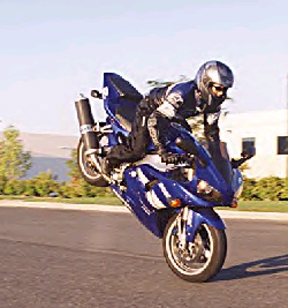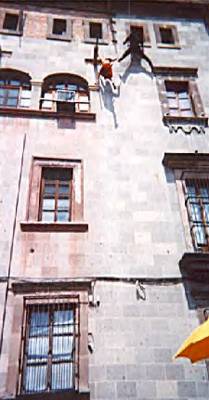
LIVES: Stuntwoman Cheryl Bermeo
AND...ACTION
The biggest myth about working as a stuntwoman is that it’s all glamorous work. It is hard work, it’s also exciting work.
It’s also a lot of sitting around and waiting.
You might be on hand, waiting, for 8-10 hours, and then you’re expected to jump up and perform your stunt within the next five minutes.
You might only get one shot at it, too, and you have to hurry, since this is going to be the last shot of the day before going into overtime. Also, the director doesn't always have a good grasp on a stunt. He knows exactly what he wants in his head, but doesn't always know how to express it in technical terms.
Directors have a vision and sometimes it’s hard for them to convey it out loud. For others, they let the stunt coordinator do their job and be creative yet safe, which they translate to the stunt person much better. They speak the same language. And they’re familiar with the risks.

Many times, you might have to improvise a stunt. You just do the best you can with the skills you have and what it is that’s needed. Your objective is to give the director his shot.
I’ve been a stuntwoman for film and TV since 1995 and did live shows which included stunts starting back in 1983. I’ve only assistant-coordinated a couple of things and I’m more interested in doing the stunts than in coordinating them. There’s a lot of work, responsibility and stress that go along with coordinating a team of stuntpeople.
Every stunt situation is different. To make a general statement, I’d have to say that most stunts are a team effort, not just with the other stunt people or stunt coordinator, but also with the effects guys, set dressing, wardrobe, etc. Each department might have a role in what your stunt entails and they all have to work together with no surprises during the stunt.
It’s frustrating when wardrobe doesn't fit properly, allowing you to do your best for the stunt, or when there’s a lack of clear communication between the people involved. These are all factors which can lead to anxiety before a stunt.
The traveling element is also pretty random. I hadn’t traveled for a job in about three years and then I traveled out of the country twice in the same year. I’ve worked in Costa Rica, St. Bart's, St. Thomas, Pittsburgh, and Key West. Of course I like the tropical areas the best, but you never know where you’ll be asked to work.
LEARNING CURVE
My initial expectations were a little different from my actual experience. Going into it, I was a professional athlete that competed in tournaments and performed shows four times a day for a live audience, so my mentality was a little different.
I had to learn to be very confident in what I did the first time, not after tons of practice. Sometimes we only get one shot at a stunt.
Also, I was used to instant positive response from a crowd. With stunts, you get a quick "good job", then you’re sent home with your paycheck. There's no huge burst of applause or feedback.

The most difficult part of my job: Downtime. We don’t usually work every day. We don’t always know when we’ll work next, either. Getting the work is harder than doing the work. We spend a lot of time trying to find work. We joke that finding the work is actually the full-time job.
The best part: Freedom. I love the freedom I have. When I’m asked to do a job, I have the choice of doing it or not. Most likely I’ll do it if it’s within my skill level, but I can make that choice.
I also love to train in physical arts, like kickboxing, motorcycle trick riding, and water skiing. I enjoy it.
As far as the actual job, I like the feeling of being able to give them what they ask for, to actually do the stunt. The pay is very satisfactory as well.
DON’T TRY THIS AT HOME
Most people think I’m crazy because I do fireburns. Out of all the stunts I perform, fireburns make people the most nervous.
Like anything else, it is knowledge that reduces the fear and I have learned about fireburns so I’m careful, but not fearful.
Others see fireburns as incredibly dangerous because they don’t understand the set up, or the properties of fire.
I won’t say that it’s easy. It looks horrific. But once you understand and learn about it, it’s much easier than it looks.
There are different stunts that can be scary for different reasons, but one that comes to mind as one of my most challenging a scene in "Once Upon a Time in Mexico", while I was doubling Salma Hayek.
I doubled her in the segment where she goes out the fifth story window with Antonio Banderas, they’re both chained together.
The scene starts there and goes through a series of descending swings until they’re near the first floor of the building.

Shown above: Bermeo gets it done, on the set of "Once Upon a Time in Mexico"
When I had to go out that window, the cameras were mounted above us, on the roof looking down, and there were no pads or safety nets below.
I was on a wire and the riggers did a great job of keeping me safe, but jumping out the window (jumping blind, because I initiated the move from the inside) and free-falling eight feet to a dead stop was very difficult.
I was hanging there, between the 4th and 5th floors, then the scene continues to where my stunt partner swings me to a grab, and then I swing him to a spot, etc. But the initial jump out the window was tough.
After each take, I had the rigger double check everything to make sure that all the ropes were still good and the safety clips were still locked.
HIGH HEELS
Personally, I think the difference in the wardrobe of a stuntwoman vs. stuntman creates a difference in the way we handle stunts, on a regular basis.
Normally, the actresses you see on TV or film are in dresses, mini-skirts, lingerie, high heels, etc. Usually something tight or body revealing. Men are mostly in baggier cloths, suits or jeans and shirts, even jackets.
When we perform our stunts, we pad up in crucial areas like the knees, elbows, shoulders, hips and/or tailbones. These will all be different for each individual, depending on the stunt being performed. With most female wardrobe, that doesn't allow for hidden pads, which would show up on camera.
Guess what that means. Right. No pads. Which leads to more bumps and bruises or more serious injuries. Doing stunts in high heels can lead to a sprained or broken ankle.

I’ve doubled Salma Hayek, Rachael Leigh Cook, Jaime Pressly and many more. It’s very important that we mimic the actor -- their walk, stance, mood, their gestures; anything that will be visible in the stunt segment.
Sometimes the stunt happens so fast that you don’t have time to worry about it, but it’s best to always try to look just like the actress. That’s the job.
Bio: Cheryl Bermeo has worked as a professional stuntwoman for most of her adult life. Audiences worldwide have seen her work in “Torque”, “Kill Bill: Vol. 1”, “Planet of the Apes” (2001), and “Kill Bill: Vol. 2”. She is a member of the Stuntwomen’s Association of Motion Pictures.
Bermeo has just been nominated for two Taurus Stunt Awards (Best High Work, Best Work by a Stuntwoman) for her stunt scenes in “Once Upon a Time in Mexico”.
Read in-depth interviews with other performing artists, in the May 2004 issue of "Arte Six".

<< Home